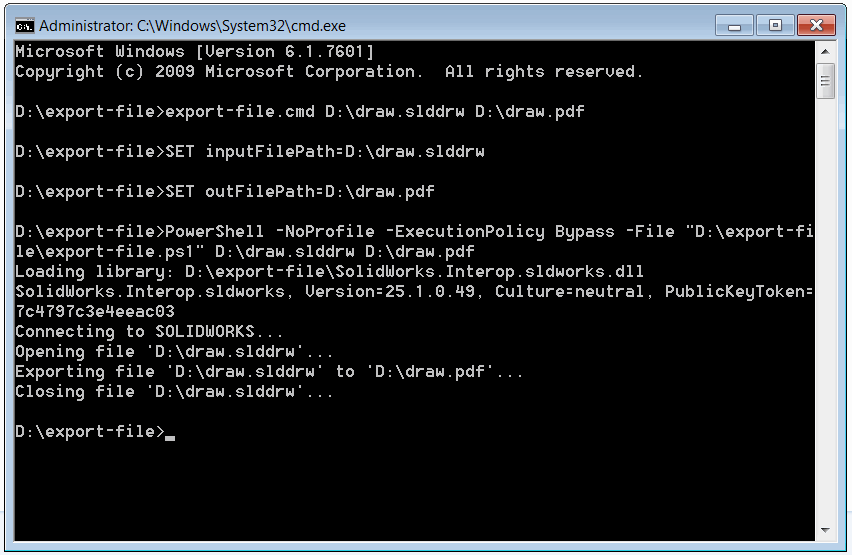使用SOLIDWORKS API在shell脚本中导出SOLIDWORKS文件
这个PowerShell脚本允许使用SOLIDWORKS API从命令行将SOLIDWORKS文件导出为指定的外部格式。
配置和使用说明
- 创建两个文件,并将下面的代码粘贴到这些文件中。
export-file.ps1
$inputFilePath=$args[0]
$outFilePath=$args[1]
$ScriptDir = Split-Path $script:MyInvocation.MyCommand.Path
$Assem = (
$ScriptDir + "\SolidWorks.Interop.sldworks.dll"
)
$Source = @"
using SolidWorks.Interop.sldworks;
using System;
namespace CodeStack
{
public static class Exporter
{
#region Libraries
static Exporter()
{
AppDomain.CurrentDomain.AssemblyResolve += OnAssemblyResolve;
}
public static void LoadLibrary(params object[] libs)
{
foreach(string lib in libs)
{
Console.WriteLine(string.Format("Loading library: {0}", lib));
System.Reflection.Assembly assm = System.Reflection.Assembly.LoadFrom(lib);
Console.WriteLine(assm.GetName().ToString());
}
}
private static System.Reflection.Assembly OnAssemblyResolve(object sender, ResolveEventArgs args)
{
foreach (System.Reflection.Assembly assm in AppDomain.CurrentDomain.GetAssemblies())
{
if(assm.GetName().ToString() == args.Name)
{
return assm;
}
};
return null;
}
#endregion
public static void ExportFile(string filePath, string outFilePath)
{
Console.WriteLine("Connecting to SOLIDWORKS...");
ISldWorks app = Activator.CreateInstance(Type.GetTypeFromProgID("SldWorks.Application")) as ISldWorks;
if (app != null)
{
Console.WriteLine(string.Format("Opening file '{0}'...", filePath));
IDocumentSpecification docSpec = app.GetOpenDocSpec(filePath) as IDocumentSpecification;
docSpec.ReadOnly = true;
docSpec.Silent = true;
IModelDoc2 model = app.OpenDoc7(docSpec);
if (model != null)
{
const int swSaveAsCurrentVersion = 0;
const int swSaveAsOptions_Silent = 1;
int err = -1;
int warn = -1;
Console.WriteLine(string.Format("Exporting file '{0}' to '{1}'...", filePath, outFilePath));
if (!model.Extension.SaveAs(outFilePath, swSaveAsCurrentVersion,
swSaveAsOptions_Silent, null, ref err, ref warn))
{
Console.WriteLine(string.Format("Failed to export '{0}' to '{1}'. Error code: {2}", filePath, outFilePath, err));
}
Console.WriteLine(string.Format("Closing file '{0}'...", filePath));
app.CloseDoc(model.GetTitle());
}
else
{
Console.WriteLine(string.Format("Failed to open document: '{0}'. Error code: {1}",
filePath, docSpec.Error));
}
}
else
{
Console.WriteLine("Failed to connect to SOLIDWORKS instance");
}
}
}
}
"@
Add-Type -TypeDefinition $Source -ReferencedAssemblies $Assem -Language CSharp
[CodeStack.Exporter]::LoadLibrary($Assem)
[CodeStack.Exporter]::ExportFile($inputFilePath, $outFilePath)
export-file.cmd
SET inputFilePath=%1
SET outFilePath=%2
PowerShell -NoProfile -ExecutionPolicy Bypass -File "%~dp0export-file.ps1" %inputFilePath% %outFilePath%
- 将SolidWorks.Interop.sldworks.dll复制到创建上述脚本的文件夹中。PowerShell脚本基于.NET Framework 2.0,因此SOLIDWORKS interop必须针对此框架。dll文件可以在以下位置找到:SOLIDWORKS安装文件夹\api\redist\CLR2\SolidWorks.Interop.sldworks.dll
{ width=450 }
或者可以指定SOLIDWORKS interop的完整路径,如下所示。在这种情况下,不需要将此dll文件复制到脚本文件所在的文件夹中。
$Assem = (
"SolidWorks.Interop.sldworks.dll的完整路径"
)
- 打开命令行并执行以下命令:
[export-file.cmd的完整路径] [输入SOLIDWORKS文件的完整路径] [输出文件的完整路径和扩展名]
结果将导出文件,并将处理日志直接显示在控制台中:
 { width=450 }
{ width=450 }